The Tory Atlas of the World
A Tory holds a political philosophy based on a British version of conservatism and traditionalism, which upholds the supremacy of social order as it has evolved throughout history. The Tory ethos has been summed up with the phrase “God, King, and Country”. Tories generally advocate monarchism, are usually of a high church Anglican religious heritage and are opposed to the liberalism of the Whig faction. In Britain, the Tory political faction originated with the Cavaliers during the English Civil War. It also had exponents in other parts of the former British Empire, such as the Loyalists of British America who opposed American secession during the American War of Independence. Following the American War of Independence, the Loyalists that fled to the Canadas referred to members of the colonies’ political elites as Tories. This political philosophy remains prominent in the politics of the United Kingdom and also appears in parts of the Commonwealth realms, particularly in Canada.
The Tory political faction originally emerged within the Parliament of England to uphold the legitimist rights of James, Duke of York to succeed his brother Charles II to the thrones of the three kingdoms. James became a Roman Catholic at a time when the state institutions were fiercely independent of the Church of Rome – this was an issue for the Exclusion Crisis supporting Patricians, the political heirs to the nonconformist Roundheads and Covenanters. There were two Tory ministries after James II came to the throne: the first led by the Earl of Rochester, the second by Lord Belasyse. A significant faction took part in the ousting of James II with the Whigs to defend the Church of England and definitive Protestantism. A large but dwindling faction of Tories continued to support James in exile and his Stuart heirs to the throne, especially in 1714 after the accession of George I of Great Britain, the first Hanoverian monarch. Although only a minority of Tories gave their adhesion to the Jacobite risings, this was used by the Whigs to discredit the Tories and paint them as traitors. After the advent of the Prime Ministerial system under the Whig Robert Walpole, Lord Bute’s premiership in the reign of George III marked a revival. Under the Corn Laws (1815–1846) a majority of Tories supported protectionist agrarianism with tariffs being imposed at the time for higher food prices, self-sufficiency and enhanced wages in rural employment.
Conservatism began to emerge in the late 18th century -it synthesized moderate Whig economic positions and many Tory social values to create a new political philosophy and faction in opposition to the French Revolution. Edmund Burke and William Pitt the Younger led the way in this. Interventionism and strong armed forces were to prove a hallmark of Toryism under subsequent Prime Ministers. Due to these Tories leading the formation of the Conservative Party, members of that party are colloquially referred to as Tories, even if they are not traditionalists. Actual adherents to traditional Toryism in contemporary times may be referred to as “High Tories”, as the traditionalist conservative values of Toryism differ from those of the more liberal and cosmopolitan members of the Conservative Party. Similarly, Tories is used to describe members of the Conservative Party of Canada, regardless if they are not traditionalists. The term Blue Tory and Red Tory has been used to describe the two different wings of the federal and provincial Conservative parties in Canada.









